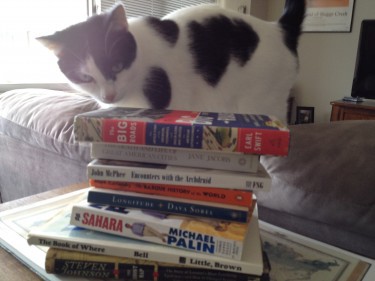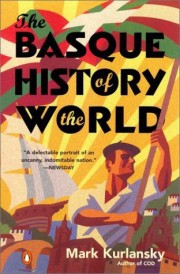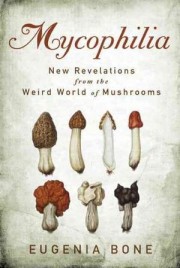A Reading List For People Who Love Learning About The World

One of the great things about geography is that it sneaks into just about everything, including books. After all, everything happens somewhere, right? When it comes to describing places, though some books stand out because they find particularly unexpected and fascinating ways to describe how the world fits together. Here I’ve collected eight favorites. Some are more obvious choices than others, but all would fit neatly on the bookshelf of anyone with a flair for the geographic.
1. The Book of Where: Or How To Be Naturally Geographic by Neill Bell
I must have been about seven when this book first came into my possession. My mom, sister and I took a lot of car trips back then, and while I usually posit my place as Trip Navigator as piquing my interest in cartography, I also owe a great debt to this book, which accompanied me on almost every one of those trips.
It’s a kid’s book of course, designed to explain spatial reasoning. The focus starts out local, at the reader’s home, and then graduates up through town, state, country, continent and globe. Along the way, the author covers a range of geographic concepts, including street numbering systems, time zones, reading maps, border disputes, latitude & longitude, and incredibly, given that it was published in 1982, an introductory discussion of global warming. All these concepts are explained in a way that makes them easily tangible, and each chapter questions (which is not to say a test) designed for the naturally curious. It sounds dry, I know, but you’ll have to trust me, it’s not. I must have read it roughly 400 times as a kid. Thinking of it recently, I bought a copy online and it remains just as relevant and great a read. I’m shocked that it’s out of print; here’s hoping it goes back into print around the time my friends have seven year olds. You can buy a copy on Amazon for ONE CENT. ONE CENT (+shipping) for a solid foundation of geographic knowledge! Bargain.
Sample Good Bit: This dedication, which reads “This book is dedicated to all those brave adventurers who step from the familiar into the unknown — from the edge of the continent or from a front porch.”
2. The Control of Nature by John McPhee
Geography, as a field, is divided into two halves: the Human and the Physical. Human geography examines cultures and communities, with an emphasis on place. Physical geography confines itself mostly to earth and earth things. In The Control Of Nature John McPhee chronicles three different places in the world where human and physical geography have disastrously intersected: In Los Angeles, where engineering efforts must protect against landslides; in Heimay, Iceland, where the citizenry are faced with the eruption of a nearby volcano; and in the Mississippi Delta, the astonishing decades-pre-Katrina struggle against the river’s coursing and flooding. Though McPhee’s writing on nature and geology is justly revered, these three pieces (originally published in The New Yorker) stand out as a master trio.
Sample Good Bit: “In an imaginative, life-loving city, there will always be people with a need to fire antique weapons. On July 24, 1977, a marksman on the Middle Fork rammed Kleenex down his barrel instead of cloth wadding. Under the Kleenex was black powder. In black powder there is more of an incendiary risk than there is in the smokeless kind. When the rifle fired, flaming Kleenex shot out the muzzle and burned down three thousand eight hundred and sixty acres, including the entire watershed of the Middle Fork.”

3. The Basque History of the World by Mark Kurlansky
To steal a line from Calvino, this one falls under the category of “Books That Fill You With Sudden, Inexplicable Curiosity, Not Easily Justified.” I first picked this book up while stuck on an unexpectedly long layover at the Pittsburgh airport, and it was a revelation. Before I read this book — I later came to realize — I had no consistent mental timeline for human history. Because everything I had learned in school I had learned in discrete sections: US history was separate from European history which was separate from “World” history, and I had no real idea of how the events I learned about in each of these classes interrelated with one another. But in this history, the Basques, who have maintained a stable society in the same place of the world, Euskadi, since before the Roman Empire, become the continuous line through which to view and analyze the events of Western history, as Kurlansky does a phenomenal job plotting the parallels between changes in Basque culture with what was going on elsewhere in the world. For me, the book was a whole new vantage from which to look at history. By the time my plane landed in Seattle, I had finished the book and I proceeded to spend the entire weekend boring the pants off my companion with excitable blathering about this little book as an Ideal Narrative of Human Geography. It is also, by far, the most-loaned book in my personal library. Not coincidentally, I’ve re-bought the book at least four separate times. Kurlansky is my favorite single-subject history writer. If Basques don’t interest you, perhaps his books on cod, salt, oysters, the year 1968, and/or American regional cuisine in the late thirties may.
Sample Good Bit: From a section on the Basques and Greater Spain after the fall of Napoleon: “The preamble to their 1812 constitution paid tribute to the Fueros, but the body of the document dismantled them. Francisco Espoz y Mina, the former commander of the División de Navarra, one of the great heroes of the war, took a copy of the constitution, placed it on a chair, and ordered it shot.”
4. The Ghost Map by Steven Johnson
We are all familiar, I presume, with the fact that cholera was cured by a map? I mean, not directly, but the discovery of the cause happened on a map drawn by Dr. John Snow, a map showing the cluster of cholera cases surrounding a water pump. The map was made in 1854, at a time when Victorian London was suffering an epidemic of cholera cases. In Ghost Map, Johnson traces the epidemic through the lives of a handful, including the outbreak’s patient zero as well as the medical folks who were convinced that cholera was spread by miasma, that is by breathing foul air. It’s an utterly fascinating chapter of Human Geography history, but a word of warning: You are going to drink so much water while reading this book. You are going to drink so much water.
Sample Good Bit: “When Prince Albert first announced his idea for a Great Exhibition, his speech included these utopian lines: “We are living at a period of most wonderful transition, which tends rapidly to accomplish that great era to which, indeed, all history points: the realisation of the unity of mankind.” Mankind was no doubt becoming more unified, but the results were often far from wonderful. The sanitary conditions of Delhi could directly affect the conditions of London and Paris. It wasn’t just mankind that was becoming unified; it was also mankind’s small intestine.”

5. A Field Guide to American Houses by Virginia & Lee McAlester
There is a meme image that surfaces from time to time taken from a book called Identifying Wood. It’s the book’s cover, and it shows a man scrutinizing a block of wood through a loupe. The title of our selection here is similarly amusing as you can imagine the identification process for American Houses going something like this, “Is it a house? Are we in America? Congratulations! You’ve spotted an American House!”
But just as with birdwatching, for which you might need the help of a guide to tell a bullfinch from a chaffinch, this field guide will help you tell a Mission-style home from a Spanish Eclectic. Encompassing the history of home construction and architectural influences from Boston to San Francisco, it also includes a million drawings and photographs of gorgeous (or strikingly hideous!) houses. Even if you have no plans of living in a non-apartment anytime soon, it’s an excellent companion to strolls through historic districts (or impressing your sofamates with surprise architectural factoids in between yelling obscenities at whatever happens to be on the Home & Garden channel. Whichever).
Sample Good Bit: ALL OF THE PHOTOS, honestly, but also the straightforward drawings, like this one.
6. Full Circle by Michael Palin
We didn’t have cable growing up, so my nocturnal television proclivities were spent with CBC and PBS, both of which broadcast a smattering of irregularly scheduled BBC programs (I suppose that’s how I learned about Monty Python?), the most memorable being Michael Palin’s travelogues. The show “Full Circle” followed Palin’s circular journey around 18 countries of the Pacific Rim. Two things I remember most about it: The Englishman’s benevolent curiosity and willingness to contend with the unfamiliar, and that they were aired completely out of order. Already a published diarist, this book is Palin’s personal journal of his travels. It was published to accompany the program, but it’s a fine read on its own — its author always charming and affable when confronted with setbacks, able to peek into a wide variety of lives without disturbing them. It’s the perfect counterpoint to “An Idiot Abroad.”
Sample Good Bit: “Only five days ago I was filming in a cupboard in Buckinghamshire with John Cleese and a tarantula spider and now here I am, just short of the Arctic Circle on a Monday morning, looking across at a Russian rock where it is Tuesday morning — the explanation for this twenty-four-hour time difference being the invisible presence of the International Date Line which slices through the Bering Strait not much more than a stone’s throw away. The Russian soldiers staring out at me from across the water have already had the day I’m having.”

7. Mycophilia: Revelations from the Weird World of Mushrooms by Eugenia Bone
If you have a sort of fearful, phobic curiosity about a subject, the best thing to do, in my opinion, is to find a good book on the subject and dive right in. This is what Mycophilia does for mushrooms, the strange little fungus footstools that can grow almost anywhere — and completely gross me out whenever I come across them. Yet Bone’s incredible enthusiasm and endless drive to encounter and map all corners of the titular ‘weird world’ is the best possible antidote to my squeamishness. It helps, of course, that she is brilliant and hilarious, too.
Sample Good Bit: “That’s why I signed up for the SOMA Wild Mushroom Camp in Occidental, California. SOMA camp usually takes place over a weekend in mid-January. I’d paid $300 and checked off my packing list, which included a sleeping bag, compass, and “favorite whistle,” among many other items not usually owned by people who live in New York apartments, then flown across the country to spend 3 days with 160 fungal-minded people. The SOMA camp (SOMA is an acronym — and a double entendre — for Sonoma Mycological Association and the holy drink of the Indian sacred text, the Rig Veda) had occupied a Christian summer camp that squatted amid young redwoods and rocky outcroppings; the cabins, shower houses, and dining/meeting hall all transformed from one obsession to another. Everything at SOMA camp was mushroomy: the names of the cabins (my travel companion and fellow New York Mycological Association member Arlene Jacobs and I were, coincidentally, assigned to the Lactarius cabin), the mushroom-shaped nametags, the mushroom paraphernalia for sale in the public space. It was like a Trekkie convention for mushroomers.”
8. American Terroir: Savoring the Flavors of Our Woods, Waters, and Fields by Rowan Jacobsen
But maybe you would like to read something shorter? WELL THEN, DO I HAVE THE THING FOR YOU. Oh, do I ever. American Terroir examines twelve foods from around the continent by looking at the location where each tastes best — salmon from the Yukon River, mussels in Nova Scotia, chocolate in Mexico, and so on. His goal is to discover what is so special about the terroir (“taste of the earth”) in those regions that make them particularly ideal for the food. Each section is perfectly commute-sized, a brief but profound chunk of regional gastronomy and, of course, geography.
Sample Good Bit: “There are fruits that act like vegetables (the tomato), there are vegetables that act like fruits (rhubarb), and then there are fruits that act like space aliens. There you have the avocado. Cut in half, it could be a flying visitor from The Jetsons. This little oddball is perhaps the only fruit that has no sugar, and it doesn’t even have the refreshing acidity so important to the appeal of citrus, apples, grapes, and most other fruits. What it does have, in abundance, is fat. Loads of heart-healthy, monounsaturated fat., which is what’s responsible for the avocado’s famously rich and creamy taste. A fully ripened avocado can have an off-the-charts oil content of 30 percent. But it can achieve such heights only in its native land. Avocados are not actually from another planet. They are from Mexico.”
Previously: The Maps We Wandered Into As Kids and Pictures Of You From Space
Victoria Johnson, cartographer, owes the Arlington public library system $9 in overdue fines. She apologizes for offending any birdwatchers or woodwatchers.
